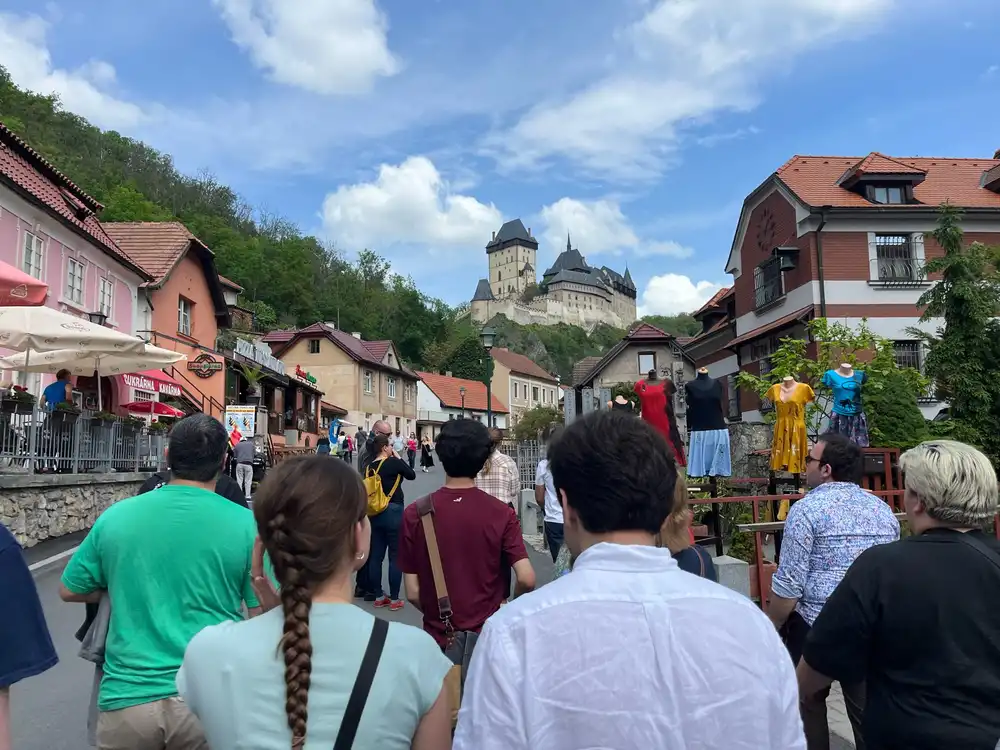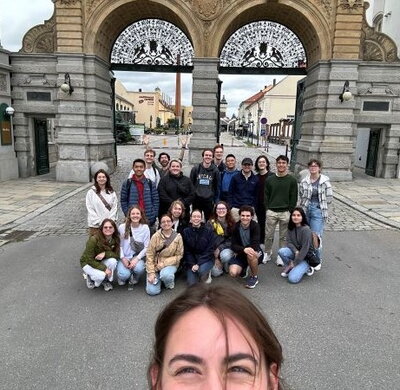
Stefan Djordjevic and Marco Jaimes wrote about the first year of our study abroad program HIST 354: 20th Century Europe in Prague. Applications are currently being accepted for the summer 2025 program. Tour one of Europe's most beautiful cities and visit locations where history was made: Wenceslas Square, the Jewish Quarter, Prague Castle, the Theresienstadt Ghetto, and the National Opera. Immerse yourself in Czech culture while exploring the region's complex history of ethnic and confessional pluralism, medieval legacies, the rise and fall of empires, and the transformation of European identity.
Learning world history, making Illini history: Inside our study abroad in Prague program
This year the Department of History, in partnership with Anglo-American University and LAS International Programs, organized its first study-abroad program in two decades under the direction of Stefan Djordjevic and Marco Jaimes. Twenty-two students travelled to Prague for two and a half weeks to study Czech history in the places it was made. Prague and the Czech Republic served as a case-study for exploring European history, focusing on Central Europe’s complex history of ethnic and confessional diversity and the challenges in navigating pluralism.
The class met for eight weeks on campus before traveling to the Czech capital in mid-May. While on campus, students gained a foundation in Czech and Central European history, including a crash course in Czech language, led by professor David Cooper of the Slavic Department. Once in Prague, students immersed themselves in Czech history, culture, and cuisine. “My favorite part of the program was the coordination between the classroom and the sites we visited. For example, we would discuss medieval Prague in the morning and visit Vyšehrad, a medieval castle, church, and cemetery, in the afternoon,” noted rising sophomore Graciela Best. Cultural immersion activities varied from dinner at a 15th century beer hall to a night at the opera. Among the highlights was a lengthy visit to Prague Castle, the largest castle complex in Europe, which started with a tour of St. Vitus Cathedral, continued with an exploration of the tower that was the site of the 1618 Defenestration and concluded with a meal at the Strahov Monastery. As rising senior Maddox de la Crux recalled “from exploring the town of Karlštejn to the Prague Castle grounds, there was never a dull moment throughout the trip, thanks to both the students and professors.”

In addition to touring sites in Prague, students visited the Pilsner Urquell Brewery and Cathedral in Pilsen as well as the Theresienstadt Ghetto. The visit to the camp was especially challenging and meaningful. Rising sophomore Henri Marchand observed that “people often talk about how visiting grand historical sites can be a humbling experience. Of all my travels, from the Colosseum to the Alhambra, this experience was the most humbling. Walking through the courtyard made me feel small as if the daily tribulations of my life were so petty compared to the sheer suffering the prisoners of Terezín endured.” Although students were already acquainted with the historical narrative of the Holocaust, standing on the site and trying to make sense of it with their peers made the immense tragedy of the Holocaust palpable in a way that books, lectures, and films could not.
Students came away from their time abroad with a richer appreciation for the materiality of history and a reverence for sites of history and memory. As rising sophomore Michael Zimmerman reflected “[it] not only deepened my connection with the history of the Czech crownlands, but also with history as a field itself."
In addition to the History Department, the program was supported by the EUC, REEEC, the Slavic Department, and the Programs in Jewish Culture & Society and Medieval Studies.
Find student testimonials about the program and follow along on their journey on our Instagram!